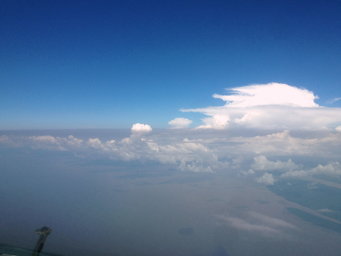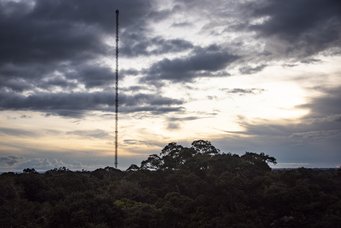At certain times in the year, more soot particles reach the Amazon rainforest from bush fires in Africa than from regional fires.
Up to two-thirds of the soot above the central Amazon rainforest originates in Africa. These are the results of a study that has now been published in Nature Communications Earth and Environment. Under the leadership of the Max Planck Institute for Chemistry in Mainz and the University of São Paulo, researchers differentiate soot particles using their relative properties and attribute them to their respective points of origin. They found that bush fires and burning savannah in the north and south of Africa make a substantial contribution to air pollution in the central Amazon all year round, thereby playing an important role in the earth radiation budget and water cycle. This is caused by the efficient transatlantic transport of particles through the atmosphere.

A plume from Africa with a high concentration of soot particles reaches the coast of Brazil.
© Meinrad O. Andreae, MPI for Chemistry
The Brazilian rainforest is one of the world’s few continental regions with clean air. However, this is only true during the wet season, when the concentration of particulate matter is very low. During the dry season, it’s a different story: numerous deforestation fires burn within the Amazon rainforest, as an “arc of deforestation” eats into the rainforest from the south. Soot and other emissions from the fires lead to a drastic reduction in air quality at this time of year. The air quality in the central Amazon at this time is no better than that in urban European conurbations. The concentration of soot particles in the atmosphere above the forest canopy fluctuates between very low and very high.
For the first time, a research team has investigated the origins of the soot particles. They made a surprising discovery: a large section of the particles do not originate in South America; instead, they travel with air masses around 10,000 kilometres from Africa over the Atlantic, stemming from natural bush fires, slash and burn practices, and the combustion of biomass, such as for cooking. “Smoke from Africa can be found virtually all year long in large amounts above the rainforest – we had not expected this”, explains Bruna Holanda, who led the study as a doctoral researcher at the Max Planck Institute for Chemistry. “We had estimated the amount of smoke from Africa would be around 5 or perhaps 15 percent. As it turns out, sometimes it reached as high as 60 percent.” According to the atmospheric physicist, this value demonstrates the efficiency of the atmospheric transport of soot and aerosol particles via air masses from Africa to South America.
Soot particles from Africa and South America are physically and chemically distinct from one another

Soot measurements were made at the Amazon Tall Tower Observatory (ATTO) in the central Amazon.
© Dom Jack, MPI for Chemistry
In order to attribute the soot above the Amazon to various sources, the researchers analysed soot particles in the air above the Amazon over a period of two years at the Amazon Tall Tower Observatory (ATTO). The research unit is situated in a virtually untouched region in the central Amazon and, among other facilities, boasts a 325-metre observation tower.
The team identified two prevailing types of soot: soot particles from Africa were considerably larger than those from the Amazon region and exhibited a lower concentration of organic material. The researchers attribute this to the fact that in Africa, the regions being burned are primarily grassland, savannah and open forests. The dryer fuel is more likely to result in flaming combustion and more soot particles. Conversely, South American fires occur in dense and moist forests. This moister fuel leads to smouldering combustion, which results in soot with a larger concentration of organic material. Using meteorological data such as the main wind field and satellite imagery, in which the smoke clouds are even visible at times, Holanda and her colleagues then determined the respective source of the smoke.
In this way, the researchers also ascertained that there are two periods a year when a particularly large amount of smoke travels from Africa to the Amazon: first, during the wet season from January to March, winds consistently bring soot combined with Sahara dust into the region. During this time, on average, 60 per cent of the soot particles above the Amazon originate from African fires. The air is in fact particularly clean during the wet season, because there are hardly any slash and burn fires in the region. However, at times the smoke from Africa makes the air as dirty in this season as it is during the dry season. Second, during the dry season from August to November, lots of soot from Africa can be observed in the Central Amazon. In contrast with the wet season, during this time there are many natural and human-made fires in the region, particularly in dry areas of the Amazon basin. In other regions of the Amazon, regional fires account for around two thirds of the soot pollution. However, a third of the soot in these regions originates in Africa, thereby exacerbating the otherwise already grave air pollution levels.
Smoke impacts the climate and the water cycle
Soot and other aerosol particles absorb and scatter sunlight, which affects the radiation or energy balance of the earth and our climate. Soot particles in particular are very active to radiation, since they absorb considerably more sunlight than they reflect, thus retaining heat in the earth system. Dust and soot particles also serve as condensation nuclei in the emergence of cloud drops. As such, they influence the formation of clouds and precipitation; in this way then, they also impact the water budget.
“Our results can help to improve climate and earth system models, which have hitherto insufficiently reflected African smoke components”, explains Christopher Pöhlker, group leader at the Max Planck Institute for Chemistry. In his opinion, the efficiency of the transport also indicated that African smoke had already reached South America in pre-industrial times, since African vegetation that was susceptible to fire had presumably been burning for tens of thousands of years. “We suspect that soot has long played an important role in soil fertilisation and forest formation in the Amazon region, as well as in the carbon and water cycles”, the atmospheric chemist continues. However, previously positive effects such as this may now become detrimental. “The deforestation rate, the number of fires, and the resulting soot in the previous years are unprecedented and could have grave consequences for regional and global climate change”, Pöhlker summarizes.








